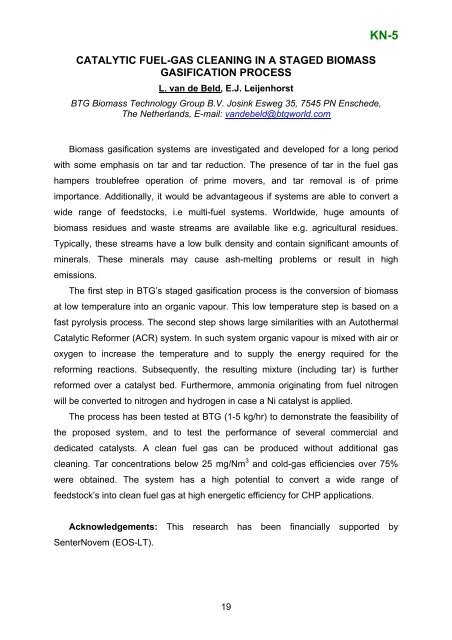Boreskov Institute of Catalysis SB RAS, Novosibirsk, Russia
Boreskov Institute of Catalysis SB RAS, Novosibirsk, Russia
Boreskov Institute of Catalysis SB RAS, Novosibirsk, Russia
- No tags were found...
Create successful ePaper yourself
Turn your PDF publications into a flip-book with our unique Google optimized e-Paper software.
CATALYTIC FUEL-GAS CLEANING IN A STAGED BIOMASSGASIFICATION PROCESSL. van de Beld, E.J. LeijenhorstBTG Biomass Technology Group B.V. Josink Esweg 35, 7545 PN Enschede,The Netherlands, E-mail: vandebeld@btgworld.comKN-5Biomass gasification systems are investigated and developed for a long periodwith some emphasis on tar and tar reduction. The presence <strong>of</strong> tar in the fuel gashampers troublefree operation <strong>of</strong> prime movers, and tar removal is <strong>of</strong> primeimportance. Additionally, it would be advantageous if systems are able to convert awide range <strong>of</strong> feedstocks, i.e multi-fuel systems. Worldwide, huge amounts <strong>of</strong>biomass residues and waste streams are available like e.g. agricultural residues.Typically, these streams have a low bulk density and contain significant amounts <strong>of</strong>minerals. These minerals may cause ash-melting problems or result in highemissions.The first step in BTG’s staged gasification process is the conversion <strong>of</strong> biomassat low temperature into an organic vapour. This low temperature step is based on afast pyrolysis process. The second step shows large similarities with an AutothermalCatalytic Reformer (ACR) system. In such system organic vapour is mixed with air oroxygen to increase the temperature and to supply the energy required for thereforming reactions. Subsequently, the resulting mixture (including tar) is furtherreformed over a catalyst bed. Furthermore, ammonia originating from fuel nitrogenwill be converted to nitrogen and hydrogen in case a Ni catalyst is applied.The process has been tested at BTG (1-5 kg/hr) to demonstrate the feasibility <strong>of</strong>the proposed system, and to test the performance <strong>of</strong> several commercial anddedicated catalysts. A clean fuel gas can be produced without additional gascleaning. Tar concentrations below 25 mg/Nm 3 and cold-gas efficiencies over 75%were obtained. The system has a high potential to convert a wide range <strong>of</strong>feedstock’s into clean fuel gas at high energetic efficiency for CHP applications.Acknowledgements: This research has been financially supported bySenterNovem (EOS-LT).19
















